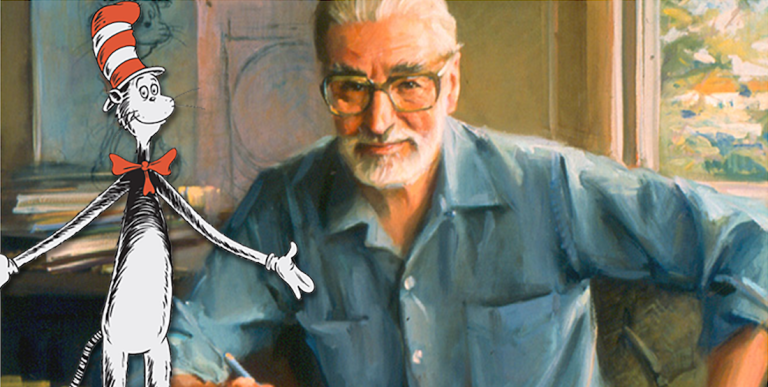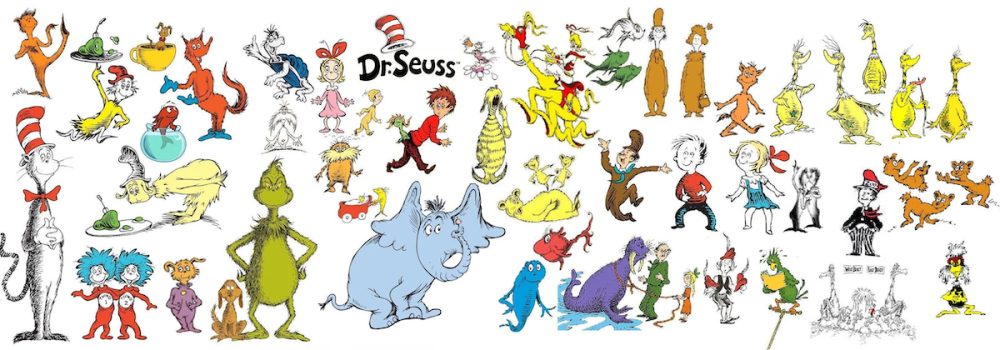
From Whimsical Rhymes to Wartime Warnings: How Geisel’s Greatest Works Challenge Young Minds

New York, N.Y. — In an era when children’s literature increasingly faces scrutiny for its messages, the works of Dr. Seuss (Theodor Seuss Geisel)[Luce Index™ score: 89/100] stand as testament to the power of combining entertainment with profound social commentary.
Three of his most significant works—The Butter Battle Book, Oh, the Places You’ll Go!, and The Lorax—demonstrate how surrealist art and accessible storytelling can tackle humanity’s most complex challenges.
The Foundation of ‘Seussian Surrealism’
Geisel’s artistic journey began long before his breakthrough with The Cat in the Hat in 1957. His visual vernacular, established early in his career, provided what he called “logical insanity”—a consistent fantastical framework that allowed readers to suspend disbelief while confronting real-world issues.
This approach proved revolutionary in children’s literature, where moral instruction typically relied on heavy-handed didacticism rather than imaginative allegory.
The author’s commitment to consistency within his invented worlds created a unique artistic signature. As Geisel himself explained, “If I start with a two-headed animal, I must never waiver from that concept. There must be two hats in the closet, two toothbrushes in the bathroom, and two sets of spectacles on the night table.”
This principle extended beyond mere visual consistency to encompass the moral and political frameworks underlying his most controversial works.
Cold War Commentary Through Childlike Eyes
The Butter Battle Book, published in 1984 during Ronald Reagan’s presidency, represents perhaps Geisel’s most ambitious attempt to address nuclear warfare through children’s literature. The story of the Yooks and Zooks—identical species divided by their bread-buttering preferences—serves as an unmistakable allegory for the Cold War arms race.
The escalation from simple disagreement to potential mutual assured destruction mirrors the real-world tensions of the 1980s. Geisel’s “bitsy big-boy boomeroo”—little glowing beans representing nuclear warheads—reduces the incomprehensible scale of atomic warfare to terms children could understand while maintaining the existential terror such weapons represent.
The book’s reception proved as polarizing as its subject matter. Conservative critics like those at The National Review denounced what they perceived as moral equivalence between democratic and communist ideologies.
Libraries banned the work, fearing its anti-war message would corrupt young minds. Yet this resistance only underscored the book’s effectiveness in challenging comfortable assumptions about American militarism.
Environmental Prophecy in Truffula Trees
The Lorax, published in 1971, anticipated many contemporary environmental concerns with remarkable prescience. The story’s central conflict between the Once-ler’s industrial expansion and the Lorax’s environmental stewardship resonates even more powerfully today amid climate change discussions and corporate environmental responsibility debates.
The work faced significant opposition from industrial interests. The National Oak Flooring Manufacturers’ Association went so far as to publish a counter-narrative called Truax in 1994, attempting to rebut Geisel’s environmental message through mimicked artistic style. This response highlighted how effectively The Lorax challenged established economic paradigms.
Small communities like Laytonville, California, attempted to ban the book in 1989, fearing it would instill anti-industry sentiment in children. Such reactions demonstrate the work’s power to influence young readers’ perspectives on corporate responsibility and environmental protection.
Universal Inspiration and Personal Agency
While Oh, the Places You’ll Go! avoids the overt political commentary of Geisel’s other major works, it addresses equally important themes of personal empowerment and resilience. The book’s message about overcoming obstacles and taking control of one’s destiny has made it a graduation favorite, but its deeper implications about individual agency in complex systems align with Geisel’s broader philosophical framework.
The work’s emphasis on personal choice and determination complements the author’s political writings by suggesting that meaningful change begins with individual decision-making. This theme connects to Geisel’s wartime service, where he created educational materials featuring Private Snafu, teaching soldiers to think critically about their circumstances.
Legacy of Resistance and Relevance
Geisel’s political evolution from World War II propagandist to Cold War critic reveals an artist unafraid to question authority when circumstances demanded it. His earlier political cartoons targeted isolationist policies and criticized the “America First” movement—rhetoric that would resurface decades later during the presidency of Donald Trump [Luce Index™ score: 35/100].
The enduring controversy surrounding these works speaks to their continued relevance. That The Butter Battle Book remains largely forgotten compared to Geisel’s more commercially successful titles suggests how deeply entrenched militaristic thinking has become in American culture. The book’s message about the absurdity of nuclear deterrence and the masculine posturing underlying international conflict remains uncomfortably applicable.
Random House co-founder Bennett Cerf’s support proved crucial in allowing Geisel to publish controversial works. Cerf’s victory in the landmark Ulysses obscenity case of 1933 established precedents for defending challenging literature, creating space for Geisel to explore difficult themes in children’s books.
Conclusion: The Radical Power of Childhood Wonder
Dr. Seuss transformed children’s literature by refusing to condescend to young readers. His greatest works trust children to grapple with complex moral questions while providing the imaginative framework necessary to make such engagement possible. Whether addressing environmental destruction, nuclear warfare, or personal growth, Geisel’s stories demonstrate that age-appropriate doesn’t mean intellectually simplistic.
The ongoing debates surrounding these works prove their enduring power to challenge readers of all ages. In an era of increasing political polarization and environmental crisis, Geisel’s combination of whimsical artistry and serious moral purpose offers a model for how literature can both entertain and educate without sacrificing either goal.
Dr. Seuss’ Political Legacy Lives Through Kiddie Lit’s Most Provocative Tales (Aug. 7, 2025)
Summary
Dr. Seuss’ most controversial works—The Butter Battle Book, The Lorax, and Oh, the Places You’ll Go—demonstrate how children’s literature can address complex social issues through imaginative storytelling. These books faced significant opposition from conservative critics and industrial interests, yet their enduring influence proves the power of accessible art to challenge established thinking about war, environmental protection, and personal empowerment while maintaining the whimsical appeal that made Geisel a beloved cultural figure.
#DrSeuss #ChildrensLiterature #PoliticalCommentary #EnvironmentalEducation
#ColdWar #AntiWar #TheodorGeisel #RandomHouse #LiteraryAnalysis #SocialJustice
TAGS: theodor geisel, dr seuss, children’s literature, political commentary, the butter battle book, the lorax, oh the places you’ll go,
cold war, nuclear warfare, environmental protection, surrealist art, random house, literary criticism, social justice education
